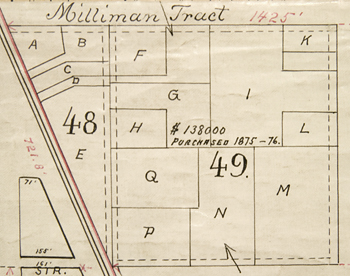December 21, 1871, Chicago Tribune: A 50 x 129 feet section of land in Block 49 had sold for $4,500.
July 20, 1874, Lincoln Park Commissioners proceedings:
A communication was received from Andrew Nelson owner of Lot P. in Comrs Partition of Blocks 48 and 49. in Canal Trustees subdivision of Section 33. Town 40. N.R. 14E. (being a part of the Milliman tract) Submitting a proposition to sell said Lot P. to the Commissioners of Lincoln Park for the sum of $19.980.00 payment to be made as follows. Cash on or before July 17, 1876 with interest at 8% per annum payable annually from date until time of payment not exceeding two years.
May 4, 1875, Lincoln Park Commissioners proceedings:
Resolved. That the proceeds of the second $100,000 of the Park Bonds sold be appropriated to the purchase of the Milliman tract, already either condemned or bargained for.
June 22, 1875, Lincoln Park Commissioners proceedings:
W.C. Goudy being present, explained the condition of the condemnation proceedings reported that Mr. Waescher owner of a part of the Milliman tract was entitled to 1,000 or 1,200 dollars more than had been allowed. On motion, Mr. Goudy was authorized to make a settlement with Waescher for the tract at best terms possible, not exceeding the sum of $17,000.
August 3, 1875, Lincoln Park Commissioners proceedings:
On motion of Comr Rehm the sum of $20,000 or so much as would cover judgment against Lot K and pt of Lot G owned by C. Schnell be paid on execution by Schnell of a Deed for same to the Commissioners of Lincoln Park; and that the sum of Six Thousand Dollars be paid to Andrew Nelson, the same to be applied on judgment agt Lot P. all in Block 49 in C.T. Subd of Sec 33.40.14.
August 17, 1875, Lincoln Park Commissioners proceedings:
The Secy report that a Deed had been executed by Caroline Schnell and her husband to the Comrs of Lot K and part of Lot G. in consideration of $21,456,52, which amount included interest from Mar 13th the date of judgment to Aug 10. 1875.
October 26, 1875, Lincoln Park Commissioners proceedings:
The Secy submitted deed from Andrew Nelson for Lot P in Comrs. Partition of Blks 48&49 in C.T. Subv. Of 33.40.14. and a receipt for $21,882.82 in full settlement of the judgment in Circuit Court in the condemnation proceedings against said Lot P.
July 31, 1876, Lincoln Park Commissioners proceedings:
…made to the Schmidt Bros owners of part of Lot F in Com’rs partition of Blds 48&49 in C.T. subv of Section 33. T 40. R14. E. under order of the Circuit Court of Cook County on the 31st day of July 1876. amounting to $13,157.14.

This 1880 map, reproduced by permission and courtesy of the Chicago Park District, shows the total purchase price of the tract for $138,000. The two arrows point to areas that may have remained unaccounted for at that time.
______________________________________________________________________________
In a curious twist, I came across a reference to the Milliman Tract while searching for something else on the Google Book Search Web Site. In a law-related book, I found a family dispute involving Iver Lawson, that included a transcription of his last will and testament. The book, still bound by copyright laws, was not completely available online. A trip to the Northwestern University Law School revealed the entire litigation.
Iver Lawson was a member of the "Milliman Committee" in 1866, while he was an alderman. He is also credited with suggesting the change of the name
Lake Park to
Lincoln Park. He died in 1872. Part of his will, written in 1871, contained a sentence that said, in part: "
… all of the real estate of which I may die seized, situate as what is known as the William (sic) tract in the old Chicago City Cemetery (now Lincoln Park) in the city of Chicago in Cook county in the State of Illinois and also in the same manner to sell all real estate of which I may die seized situate outside of the present limits of said city of Chicago …"
I found no other reference anywhere, of Iver Lawson owning any part of the Milliman Tract.

